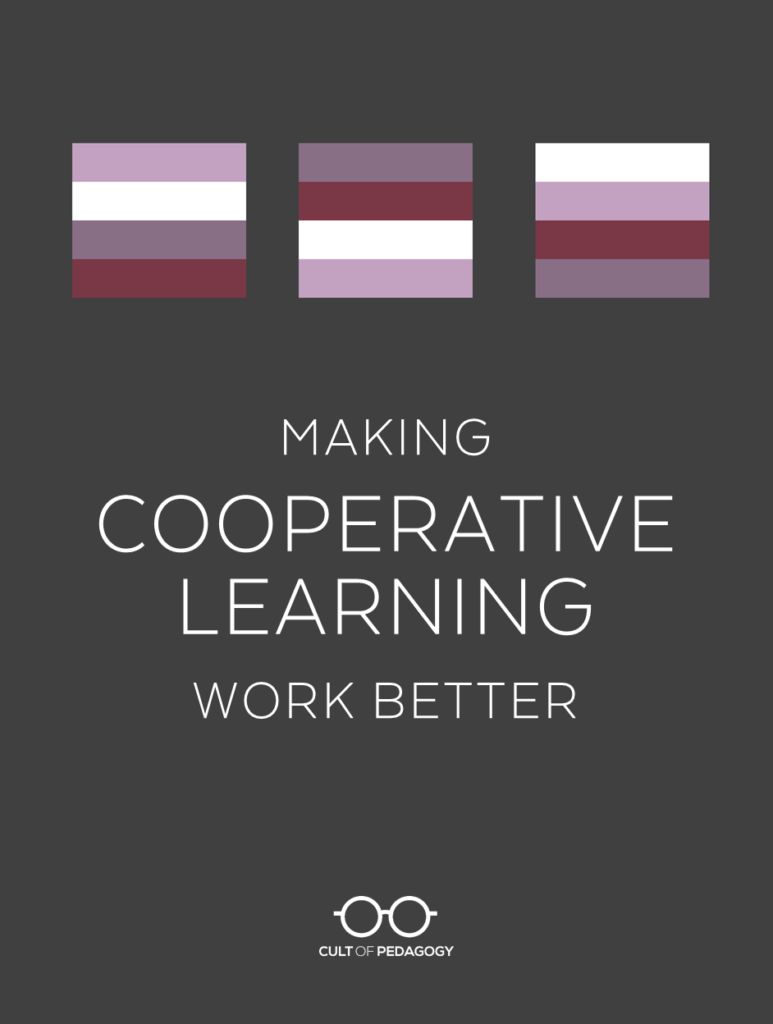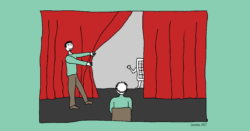
Listen to this post as a podcast:
Sponsored by Pear Deck and Participate
As a middle school English teacher, I incorporated plenty of group work into my instruction. I did it for a number of reasons. Sometimes it was because a task seemed like a natural fit for cooperative learning, like days when I wanted students to brainstorm ideas together. Other times it was just to mix things up and do something different. And then there was the “fewer grades” principle: If I had 120 students and I gave an assignment to groups of four, that meant I would only have to grade 30 final products, rather than 120.
It didn’t always go well, though.
Student contributions were uneven. Some groups were better at staying on task than others. A lot of time got wasted. Personalities conflicted. Absences created logistical headaches. Not only did I observe these problems as a teacher, I had also experienced them plenty of times as a participant in group projects. I was the classic “just let me do it all” person: Sensing early on in most situations that other group members weren’t going to add much value, I ended up taking on most of the work myself.
Despite it all, I never quite gave up on cooperative learning as a teacher. Not only did I believe in its inherent value—that as humans, we need regular practice in working together on things—but I knew that research said it was a good thing. At least, I was pretty sure it did.
As I talk with teachers about this, I’m finding that my experiences have been fairly typical: Many of us want to use cooperative learning in our classrooms, but we wish we could get it to work better. So I went in search of answers by taking a look at the research and asking for help in this tweet and this one.
And now I have the answers to two questions.
First, Is cooperative learning worth it? What does the research say? Beyond academic research, are there philosophical, “human” reasons we should keep taking it on?
Second, How do we solve some of the most common problems with cooperative learning? After seeking input from scores of teachers and mining my own experiences, I’ve settled on a list of four of the most pressing issues with cooperative learning. For each one, I’ll share some of the most effective solutions coming from practicing classroom teachers and organizations that have developed formal systems for collaborative work.
Let’s begin.
Is Cooperative Learning Worth It?
If most of the cooperative learning we implement only gives us lukewarm results, it makes sense to ask if we should even bother. Why not just have students work alone all the time?
What the Research Says
I’m going to keep this brief: Rather than dig through piles of studies on cooperative learning, I found one big overview of decades of research that has been done on the subject (Gillies, 2016).
Here’s the big takeaway: In general, when students work together, they make greater academic and social gains than when they compete against one another or when they work individually. But merely putting students into groups is not enough to realize these gains. To be effective, cooperative work needs to be structured so that it embodies five key components:
- positive interdependence: Group members must work together to achieve a common goal.
- individual accountability: Each member is responsible for doing his or her part.
- promotive interaction: Group members help, support, and encourage each other.
- effective interpersonal skills: Students are taught how to communicate, solve problems, and resolve conflict effectively.
- group processing: Groups are given time to reflect on how well their group functioned and to make plans for improvement.
Beyond Research: Why Cooperative Learning Matters in the 21st Century
Apart from the academic and social gains cooperative learning has offered for generations, we now find ourselves in an era where it may be more essential than ever before.
For one thing, it gives students practice in the kind of skills that are becoming more desirable in the workplace. P21’s Framework for 21st Century Learning includes collaboration as one of its essential skills. As manufacturing is automated and information can be obtained with a few clicks, higher-level skills like communication, creativity, and collaboration are more valued—these are skills computers can’t really replicate. The work of human beings is going to involve more and more of those kinds of skills in professional spaces, higher education, and community life.
On a deeper level, we need cooperative learning because technology is really starting to limit our face-to-face communication. Even when we’re in school together, we are on devices so much of the time. This can be wonderful and efficient, and it offers so many more opportunities to expose ourselves to new ideas, but it is stunting our ability to have regular conversations and robbing us of all the gifts that come with those interactions. Giving students regular opportunities to share physical space and actually talk through complex problems is a gift they may not get anywhere else, so yes, it’s worth it.
Four Common Problems with Cooperative Learning
Problem 1: Student contributions are uneven; sometimes vastly uneven.
It came as no surprise to me that this was the most frequently mentioned drawback teachers experience with cooperative learning. This problem shows up in different ways: The academically strong students end up doing all the work, while others slack off or give up because they can’t find a way in. Or maybe students contribute an equal amount, but they don’t actually work together; instead, they just divide up the work, then copy off each other’s papers.
Unfortunately, many teachers assume this problem is caused by students not wanting to work together, but I think it often comes down to two larger issues: First, students haven’t been taught collaborative skills. And second, the task has not been structured for true collaboration.
Solving this problem is not simple or one-dimensional. It will most likely require several different approaches: explicitly teaching collaborative skills, using some type of structure so that roles and procedures are more clearly defined, and setting norms and expectations ahead of time.
Explicitly teach collaborative skills.
If students are going to do good collaborative work, they need to be explicitly taught collaborative skills.
- Teach these skills in the same way that you’d teach academic material. Do role-plays, model the behavior you want to see, do demonstrations of what not to do. If needed, re-teach the skills throughout the year. Do not assume students have already been taught how to collaborate or that they should know better. Chances are very good that neither of these are true.
- Train students on collaborative skills by working on shorter, easier projects at first, then have students reflect on how well they collaborated. Only have them tackle a bigger project after they have mastered the collaboration skills.
- If you’re going to teach collaborative skills, you need to identify what the skills are. One great set of resources comes from PBLWorks, where you can download rubrics for assessing collaborative work. Whether you use the rubrics to actually perform assessment or not, they can help you identify the skills needed for effective collaboration.
Use cooperative structures.
In my own classroom, I rarely did anything to actually structure group work. I was barely aware that formal structures existed for this type of thing. Since then I have learned that quite a few of these have been developed to provide a framework for collaborative tasks. To implement most of these well, some training or professional development will likely be necessary. Some of the structures that were recommended by teachers are listed here:
- Team-Based Learning
Learn More
Popular in medical schools but applicable for K-12, this method groups students into heterogeneous teams that stay the same over the course of a whole semester. It includes steps that ensure each team member has prepared ahead of group work with pre-reading and other tasks, and has built-in structures for individual accountability. Team-Based Learning seems to be most appropriate for courses where students are expected to demonstrate learning of and think critically about a large body of content. - Agile Project Management
Learn More
This approach to managing large, complex projects comes from the world of software development. It breaks large projects into shorter cycles, where parts of the project are developed and then assessed for quality so the team can make changes as they go. Two of Agile’s most well-known formats are Kanban and Scrum, which is now available in a version made specifically for schools called eduScrum. Agile seems most appropriate for project-driven courses, where students need to come up with creative solutions to problems, rather than courses driven more by knowledge acquisition.
- POGIL (Process Oriented Guided Inquiry Learning)
Learn More
This structure is most often used in science courses, but can be done in other content areas as well. In assigned, self-managed teams, students are given specific roles to carry out as they work through an activity designed to deepen their understanding of the content. Just like with Team-Based Learning, this seems to be best suited for courses that are more content-driven than those that focus on individual creativity or skills. - Kagan Cooperative Learning Structures
Learn More
Dr. Spencer Kagan’s work on cooperative learning has been a teacher go-to for decades, giving us structures like Quiz-Quiz-Trade and Numbered Heads Together. The company offers professional development and lots of other resources, but probably the best (and most affordable) place to start would be with their book, Kagan Cooperative Learning, which provides a full overview of the structures and how they work. These are appropriate for all content areas and grade levels, but the artwork of the site and book suggests they are geared more toward grades K-8. - Solve in Time
Learn More
This structure was created to help teams solve problems with a design thinking approach. Students work through steps of clearly defining a problem, researching and understanding it, coming up with a solution, then sharing it. - Jigsaw
Learn More
This strategy isn’t necessarily designed for projects, but rather for having students learn a discrete body of information together. Each group member is tasked with learning a chunk of the material, then teaching it to the rest of the group.
Establish norms and expectations ahead of time.
Rather than solve problems only when they come up, many teachers have students create group contracts before starting work. Developed with input from all group members, contracts outline members’ expectations and describe how students will respond when problems arise. These resources can help you get started with developing contracts:
- From New Tech Network:
Group Contracts for Collaborative Work - From PBL Works:
How to Create More Meaningful Team Contracts
Problem 2: Interpersonal conflicts interfere with productivity.
Sometimes students just can’t get along well enough to work together. These conflicts sometimes exist prior to a group’s formation; students may have a history with one another that has nothing to do with your class. Personal problems can also arise after group work starts, as students discover personality traits that create irritation or conflict.
These kinds of conflicts should not be treated lightly. When students don’t feel socially or emotionally comfortable with other group members, they won’t be willing to take the kinds of risks that are necessary for learning. In a 2-year study, Google interviewed hundreds of its employees to determine what qualities made some teams more successful than others. They identified 5 key traits, and the one they said was most important was psychological safety. Similarly, a 2017 University of Washington study reported that students who “felt more comfortable” in their group showed a 27% increase in content mastery over those who did not (Theobald, Eddy, Grunspan, Wiggins, & Crowe, 2017).
Here are some ways teachers have optimized interpersonal dynamics in groups:
- Start with team-building. For teams that will stay together for more than a class period, it’s worth it to delay the academic work at first and focus on building the team relationship. One way to do this is through team-building games and activities. The website Playmeo has lots of these you can try.
- Survey students ahead of time. Before creating groups, have students complete a form indicating which classmates they would prefer to work with and if there are any they would rather not. Recognize that for some students, the reasons for not wanting to work together could run deep with painful memories; do not dismiss preferences as students “just wanting to work with their friends.”
- Survey students during group work. Some teachers have students complete daily reflection sheets where they indicate how well they felt their group worked together that day. These can help you detect problems early on so they can be addressed right away.
- Work with students to problem-solve. In some cases, rearranging groups or allowing some students to work independently may be the most logical solution. But at other times, the teacher can work with students who struggle in groups to develop better social and collaborative skills.
Elementary teacher Erin Gannon used some of the above solutions with a student whose dominant personality and poor impulse control made others ask to not be grouped with her. Gannon worked with the student one on one to practice strategies for giving others more opportunity to lead. She also talked privately with the other group members.
“We ALL came up with a plan together for what would happen if she started to ‘feel prickly,'” Gannon says. “(The student) wasn’t perfect but they genuinely cheered her on when she had good days. It took a lot of work but I would have devoted the same attention to an academic need. She was an excellent student, very sweet, with great leadership abilities, but that trouble working with others could really have hurt her down the road. I think my other students really needed to better understand the situation and not just shun her. If students are working in teams there should be a sense that we are all responsible for each other’s success. Empowering them to be part of the solution is pretty powerful.”
Problem 3: Off-task behavior wastes time.
Whether it’s excessive talking, inappropriate device use, or general fooling around, a lot of cooperative time can be wasted when students just aren’t doing the work they’re supposed to be doing. Here are some ways to tackle this problem:
- Do check-ins. Establish specific tasks or benchmarks that groups need to complete and show you when they’re done. Breaking the larger project into smaller tasks not only keeps everyone moving, it can also tell you which groups are starting to fall behind the others. These check-ins can be required for individuals or for whole groups. Some teachers assign points or grades for these to add extra incentive.
- Use a timer. Several teachers said that setting a timer for the completion of certain tasks helped keep groups on track.
- Look at the assignment. Students may have trouble focusing on the task because it doesn’t really engage them. Maybe it’s not personally meaningful to them, maybe it’s too easy, maybe it’s too confusing. Any of these shortcomings can make it much more difficult for students to stay on task, and no matter how many checks you put in place, if it’s an uninspired or poorly designed assignment you’ll be fighting an uphill battle.
Problem 4: Student absences can throw everything off.
Ideally, all group members will be present for the whole lifespan of a project. But things happen, and the longer the project, the more likely you are to have absent students. One missed day is usually not a big deal, but if a student misses multiple work days when the group should be actively collaborating, it becomes much harder for that person to make an equal contribution. Here are some ways teachers have found to work around this issue:
Plan ahead.
- Design projects where some components require all group members’ participation, but others are done by individuals and might even be considered “like to have” rather than “must have.” That way if one person is unable to do their part, that part can just be dropped without impacting the whole project.
- Make sure roles and responsibilities are clearly defined ahead of time for each student so that the “work” doesn’t just get pushed around randomly. If a student is absent for a few days, it’s clear what they need to do to catch up, and if they are unable to do it, the other group members can decide who takes on their tasks.
- If students set goals together and include contingencies for absences in a group contract, then there will already be an agreed-upon plan to put into action.
Leverage technology.
- Have students use a platform like a shared Google Drive or a HyperDoc for keeping all project materials in one cloud-accessible place. As long as the absentee has home internet access and is well enough to work, he or she can keep at it from home.
- Some teachers allow groups to use Skype, Facetime, or Google Hangouts to video chat with the missing group member during regular class time.
- If live video chat isn’t an option, students could still document their meeting with video and share that with the absent student later.
Course correct.
- If a student’s absence lasts long enough to impact the group and the above solutions aren’t working, the teacher may redistribute the workload among remaining members, remove the student from the group, and give that student an individual assignment to replace the group task. If you spell this out in the contract and/or rubric ahead of time, the process should be fairly straightforward.
A Few More Tips
- Don’t send work home. Because home environments vary so greatly and students have different access to materials, transportation, etc., it’s best to keep all collaborative work in the classroom. Moreover, expecting students to meet outside of class time, especially if they are younger and don’t have their own transportation, will automatically create problems within groups and from group to group.
- Keep groups to 3-4 students. This seems to be the general consensus from expert readings to talking with individual teachers. Once a group gets larger than 4 it becomes easier for students to slip through the cracks.
- Check out collaborative tech. While many schools are already using Google’s collaborative tools, other tools have collaboration features that you may not be aware of. Some are built specifically for collaboration and project management, like Trello, Asana, Kanbanchi, and Slack. Other tools like Wakelet for curation and Canva for graphic design allow students to collaborate on projects from anywhere they have internet access.
The bottom line is this: If cooperative learning hasn’t really worked for you in the past, don’t lose hope. There are so many people out there who have come up with fantastic ways to get it right, so pick yourself and your students back up, try some of the stuff we’ve covered here, and see if you can make it better next time.
References:
Gillies, R. M. (2016). Cooperative learning: Review of research and practice. Australian Journal of Teacher Education, 41(3). Retrieved from https://ro.ecu.edu.au/cgi/viewcontent.cgi?article=2902&context=ajte
Theobald, E.J., Eddy, S.L., Grunspan, D.Z., Wiggins, B.L., & Crowe, A.J. (2017). Student perception of group dynamics predicts individual performance: Comfort and equity matter. PLOS One, 12(7): e0181336. https://doi.org/10.1371/journal.pone.0181336
Join our mailing list and get weekly tips, tools, and inspiration that will make your teaching more effective and fun. You’ll get access to our members-only library of free downloads, including 20 Ways to Cut Your Grading Time in Half, the e-booklet that has helped thousands of teachers save time on grading. Over 50,000 teachers have already joined—come on in.





This is all so true. I have had very few successes. VERY few. I think at the middle school level, the psychology safety is huge…and changes OFTEN.
I teach in a competitive college-prep high school in which the focus on grades WAY outweighs the focus on learning. My biggest issue with group work is the difficulty in being able to defend my grading accurately. Unless I make projects easily partitioned (e.g. recorder, presenter, etc…), I am guaranteed at least one parent phone call.
The emotional and logical feel for the need to defend grading comes from a incorrect desire by society and parents and school administration to have grades based on objective grading. This is the key here. Objective grading versus subjective grading practices. We see this need to remove the scoring practices out of the hands of the educator when the system stresses objective scoring. The unconscious urge to not trust the expert stems from a distrust of the fairness of the person and the need for reproducible results. This inherent weakness in the person being graded and the parents stems from distrust. They have a general weakness and fear of the power of the grader and desire to remove that power by placing it in the hands of in impartial system, i.e. objective grading. Teachers who seek to placate these urges by moving their systems to a objective based grading practice have both shown their own internal weakness to stand firm on principles and fallen prey to the demands of the objective crowd that they submit to objectivity as THE only practice allowed. In the end, the powerful subjective teacher will not only resist but seek to destroy these promoters of objectivity. Objectivity is based on a desire to strip humans from their humanity, to make us all emotionless robots, and to turn us in to automatons that (notice I did not say who) neither think freely, have imagination, or finally…matter. Humans do not matter when they are not human. Objectivity kills humans turning them into sterile, unthinking, robots best left to the trash heap where they belong. ALL teachers should and must cast down these oppressive forces through all means, so that we can stand firm in the truth that subjective grading is the proper methodology of grading.
Thank you for this podcast! I love cooperative learning! I use Kagan and eduScrum. I have had great experiences watching my students grow and learn as people. It is worth the effort! Thank you for mentioning eduScrum! This has added the final structure needed in my classroom. These three; organization , commitment and communication build the necessary pieces to build trust in a group. If you are needing to fire up your cooperative knowhow check out eduscrumusa.com
Hi Sue,
thank you for the shout out…
Here a video of you talking about how you use eduScrum for project-based learning
https://www.youtube.com/watch?v=LFvnAhODhks
Cheers
Christian
http://www.eduScrumUSA.com
I love your statement “Giving students regular opportunities … is a gift they may not get anywhere else ….” So often we overlook the fact that we may be giving students a valuable skill they’ll not get outside our classroom. The ideas in this article will surely have a positive impact on teachers seeking better ways to implement cooperative learning.
When I’ve done cooperative learning, I’ve been very conscientious about how I structure groups, especially at the start of the school year. We can’t expect academically challenged students to keep up with those at a much higher level, so grouping is key to making sure all students can succeed. Once students have established strong cooperative learning skills, then we can be more random in assigning groups.
BrP
Thank you for the shout to agile in learning and eduScrum!
As eduScrum in the USA we want to support learners, teachers, and leaders to be agile, self-manage and realize their human potential. We use eduScrum as tool.
Here is a video with some impressions from the whole school implementation at Patiño High School in Fresno, California.
https://www.youtube.com/watch?v=nzD-YA3Vqwo&feature=youtu.be
Cheers,
Christian
Founder eduScrum USA
http://www.eduScrumUSA.com
I find it strange that in such an important article you haven’t attempted to make a distinction between cooperation and collaboration, in fact you seem to use the terms if they are synonymous? And yet the distinction is absolutely critical and particularly critical to many of the issues that you highlight in your article.
In a nutshell the difference could be summed up as:
Cooperation = parallel practice
Collaboration = integrative practice
Ferguson explains it better here:
(From Interthinking, Putting Talk to Work, citing Ferguson Thesis, p74)
Co-operation is a goal-centred activity (Panitz, 1996) in which different things are done by different actors in order to achieve their goal (Van Oers & Hännikäinen, 2001). It involves splitting work, solving sub-tasks individually and then assembling the partial results to produce a final output.
Collaboration, on the other hand, involves partners carrying out work together (Dillenbourg, 1999). It is a co-ordinated activity, the result of a continued attempt to construct and maintain a shared conception of a problem (Lipponen, 2002); an interaction in which participants are focused on co-ordinating shared meaning (Crook, 1999). It requires more than the effective division of labour that constitutes cooperative work. Participants must negotiate mutually shared or common knowledge in order to work together to solve a problem or perform a task together (Littleton & Häkkinen, 1999). It is also important that they understand the conditions for collaboration and rules for coordinating their efforts (Häkkinen, 2004).
This is pure semantics. Why worry if it’s cooperative or if it’s collaborative? It’s more important to know the many aspects needed to structure it correctly, and how this differs depending on the subject, age, and the Bloom’s Taxonomy objective.
I love this focus on collaborative learning and can see the link between learning here from student activity and how faculty staff teams across many site locations can benefit from some of the core learning.
Very interesting points, collaborative learning is something that I will consider in future and I can see the benefits of collaborative learning and the link between learning that involves students as well as the teaching staff.
Very interesting points, collaborative learning is something that I do, however I plan to add more of it into my teaching. I can see the benefits of collaborative learning and the link between learning that involves students as well as the teaching staff.
I feel that small group work is more beneficial than larger groups. At the start of the academic year students can find this difficult but as they progress they feel more comfortable in joining new groups as set by tutor and performing well with peers. Larger groups can leave some learners lost amongst so initial grouping is important.
I found this very interesting, with many useful ideas that l will implement.
I really enjoy group work, when it is successful.
It is clear in every area, that l have to re evaluate my methods. I am really looking forward to the challenge, and evaluating the results.
I just had a quick look at playmeo website, suggested in this talk. I liked the concept of trust building in cooperative learning requiring students to stretch outside of their comfort zone to explore and develop critical interpersonal skills. I think this is one of the issues that students need to work on as they often get used to be confident in only their own group and usually they tend to stay in those group till the end of the academic year.
Is Cooperative Learning Worth It? Having seen group work in class I have seen all outcomes from harmonious groups to infighting to rebellion – its a good insight into human psychology
I love the concept of collaborative learning, which I have heard about for a few years now but only ever done singular activities. My biggest question is how to teach those collaborative skills–whatever they may be–well. I know there’s a small tidbit in this article about explicit teaching, but I would love to read more concrete information about what that looks like. Does anyone have any leads?
Hi Natalie! This might be resource overload,but I recommend combing through Cult of Pedagogy’s Cooperative & Collaborative Learning Pinterest board. Our curator is fantastic at what she does, so I’m sure something here will be what you’re looking for!